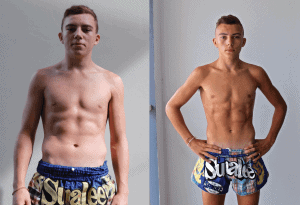Blogpost: Performance and Aesthetics in Athletes
By SBG Performance & Nutrition
Getting the right balance between performance and aesthetics is one of the challenges I have found whilst working with Muay Thai fighters. Who doesn’t want to look shredded in the ring, right? But how far do we take it? Are we going to compromise performance and recovery just so that our fighters can look ripped in their fights? This is a problem I have struggled with over the past few months whilst working with Sumalee sponsored fighter, Jordan Coe.
As you may recall from my blog posted late last year (find it here), Jordan came to me with real struggles. He was having trouble cutting down to his preferred fighting weight of 57kg and was finding it even harder to achieve the lean look that he had been able to maintain quite comfortable only a year or so before. When I started working with him I did an initial evaluation of his diet and found that he was maintaining weight at around 1600 kcal. In my opinion, this is far too low for the volume and intensity of his training and went some way to explaining why he could no longer shift the last bit of excess weight without using extreme tactics.
Not only that but Jordan’s performances were suffering in the ring. He said he felt bloated, fat (even though he was only about 12% body fat), sluggish and tired and was on quite a bad losing streak before we started working together. He would also binge on junk food (mainly sweets and ice cream) after his fights which would push his weight back up again. It was a vicious cycle which needed to be broken for him to progress as a fighter.
This is where my dilemma arose. As a coach I was not comfortable dropping his calories any lower in a bid to drop his last bit of body fat. I felt that his metabolism was not where it should be and dropping calories further would make his quest for fat loss become even harder. His performance in training and his recovery would suffer and that is not what anyone wanted. On the other hand he was clearly suffering with the fact he was heavier than he thought he should be and could not train properly with this distraction on his mind.
Something had to be done.
My main concern was increasing his calories very slowly over the period of many months to increase his Basal Metabolic Rate without gaining fat. His main concern was looking ripped in his fights.
The first step was to make it clear to him that I wanted to help him achieve his goals but that it would not happen over night. Every morning before training he would religiously take the gym scales to the bathroom and weigh himself in the hope he would have dropped weight. I had to start by explaining to him that it was pointless weighing himself every day as there are so many factors that contribute to the number he was seeing on the scales. Food in the gut, the amount of sodium consumed the night before etc etc could all have had a bearing on the weight he was recording each day and could explain random fluctuations. I explained the best way to see if we were on track was to take an average over 1-2 weeks worth of weigh-ins. I also don’t think it is healthy being so focused on the number on the scales (didn’t take in to account body composition) when training should be more of a concern. If he saw a number he didn’t like, it would ruin his whole day. Not healthy.
So, the challenge was to get him happy with himself in the mirror whilst optimising performance and recovery. Luckily Jordan is a great professional and was willing to listen to my advice.
I have to admit I did initially concede to his demands. Our agreement was that if I got him to a weight where we has happy, afterwards I would be free to do as I please with his diet. Luckily this didn’t involve too much of a calorie drop, a mere 100 calories per day in fact. This combined with a high fat menu on his rest day and he was flying.
The problem with trying to do this in Thailand is having to deal with the short periods between fights (usually 2-3 weeks at best). It became more difficult to start playing around with calories knowing that any fluctuation will potentially ruin Jordan’s day and with it his training. This meant being on point with his calories and macros every week and ensuring that he was feeling good in each of his training sessions.
Luckily, the weight started to come off without any real set backs and I could see he was visibly happier day to day. We can attribute that in part to the high quality, nutrient dense foods he was consuming as part of his daily meal plans which would give him good, sustained energy. As I mentioned before there really wasn’t much body fat to lose but seeing the number on the scales drop was a massive boost psychologically for him. Over time he began to realise that it was not necessary to weigh himself every day and it was more about how he felt and performed during training and his fights.
It was a big hurdle for him, being in a place where he wasn’t constantly stressing about eating or binging after periods of under-eating before fights. Don’t get me wrong he was allowed to indulge a little after his fights, but that indulgence wouldn’t last for 3 days anymore.
If he ever started to feel flat then we would incorporate a re-feed meal to kick start his metabolism and give him a mental boost. We eventually got him to a comfortable weight of 62.5kg where he looked good in the mirror, felt on top of training and was performing better than ever in his fights (since we started working together he has had 4 fights and won them all).

It is now my time to take care of what I want to do. With him sitting at a comfortable weight I can slowly start to increase his calories without him gaining unwanted body fat. This increase was as little as 120 calories A WEEK which works out at about 10-12 calories per day. This sounds like nothing and really, it is. But this will accumulate over the course of weeks and months until he is able to comfortably take on far more calories than he is at the moment, thereby increasing his capacity to perform and recover. Initially the increase will come from animal protein. From there it is a case of playing around with the other macronutrients. At the moment we have him at a ratio of 30% protein, 30% fat and 40% carbs. This gives him good energy and satiety throughout the day.
I am confident that I can increase his calories quite dramatically without him gaining any unwanted body fat. I will be documenting our progress over the next few months with more information as well as insights into the techniques used.

